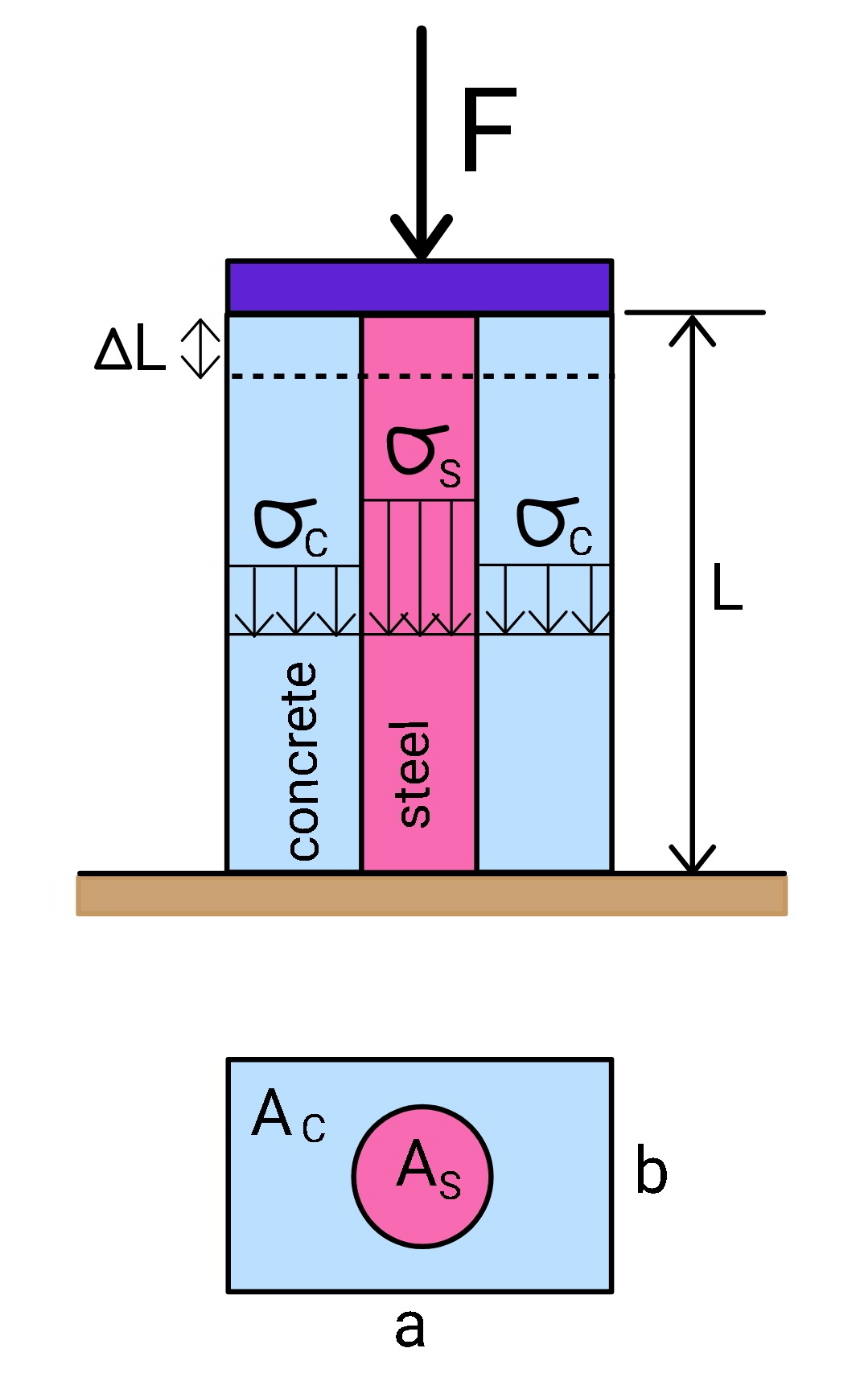Question Number 157775 by mr W last updated on 27/Oct/21

Commented by mr W last updated on 28/Oct/21

$${let}'{s}\:{say}\:{we}\:{have}\:{a}\:{column},\:{composed} \\ $$$${of}\:{concrete}\:{and}\:{steel}.\: \\ $$$${say}\:{the}\:{cross}−{section}\:{of}\:{concrete}\: \\ $$$${is}\:{A}_{{C}} ,\:{and}\:{that}\:{of}\:{steel}\:{is}\:{A}_{{S}} .\: \\ $$$${the}\:{overall}\:{cross}−{section} \\ $$$${of}\:{the}\:{column}\:{is}\:{A}_{{overall}} ={A}_{{C}} +{A}_{{S}} . \\ $$$${in}\:{case}\:{of}\:{rectangular}\:{cross}−{section}, \\ $$$${A}_{{overall}} ={ab}. \\ $$$${A}_{{C}} ={A}_{{overall}} −{A}_{{S}} ={ab}−{A}_{{S}} . \\ $$$${when}\:{the}\:{steel}\:{consists}\:{of}\:{n}\:{rebars} \\ $$$${with}\:{diameter}\:{d},\:{then} \\ $$$${A}_{{S}} =\frac{{n}\pi{d}^{\mathrm{2}} }{\mathrm{4}}. \\ $$$${let}'{s}\:{say}\:{the}\:{length}\:{of}\:{column}\:{is}\:{L}, \\ $$$${the}\:{load}\:{is}\:{F}.\:{under}\:{the}\:{load}\:{the} \\ $$$${column}\:{obtains}\:{a}\:{deformation}\:\Delta{L}. \\ $$$${since}\:{concrete}\:{and}\:{steel}\:{are}\:{a}\:{composite}, \\ $$$${both}\:{have}\:{the}\:{same}\:{deformation}. \\ $$$${the}\:{strain}\:{of}\:{both}\:{materials}\:{is}\:{the} \\ $$$${same},\:{which}\:{is}\:\epsilon=\frac{\Delta{L}}{{L}}. \\ $$$${say}\:{the}\:{Young}'{s}\:{modulus}\:{of}\:{concrete} \\ $$$${is}\:{E}_{{C}} \:{and}\:{that}\:{of}\:{steel}\:{is}\:{E}_{{S}} ,\:{then} \\ $$$${the}\:{stress}\:{in}\:{concrete}\:{is}\:\sigma_{{C}} ={E}_{{C}} \epsilon, \\ $$$${and}\:{the}\:{stress}\:{in}\:{steel}\:{is}\:\sigma_{{S}} ={E}_{{S}} \epsilon. \\ $$$${the}\:{internal}\:{force}\:{in}\:{concrete}\:{is} \\ $$$${N}_{{C}} ={A}_{{C}} \sigma_{{C}} ={A}_{{C}} {E}_{{C}} \epsilon \\ $$$${the}\:{internal}\:{force}\:{in}\:{steel}\:{is} \\ $$$${N}_{{S}} ={A}_{{S}} \sigma_{{S}} ={A}_{{S}} {E}_{{S}} \epsilon \\ $$$${we}\:{have}\:{N}_{{C}} +{N}_{{S}} ={F}. \\ $$$${A}_{{C}} {E}_{{C}} \epsilon+{A}_{{S}} {E}_{{S}} \epsilon={F} \\ $$$$\Rightarrow\epsilon=\frac{{F}}{{A}_{{C}} {E}_{{C}} +{A}_{{S}} {E}_{{S}} } \\ $$$$\sigma_{{C}} ={E}_{{C}} \epsilon=\frac{{E}_{{C}} {F}}{{A}_{{C}} {E}_{{C}} +{A}_{{S}} {E}_{{S}} }=\frac{{F}}{{A}_{{C}} +\frac{{E}_{{S}} }{{E}_{{C}} }{A}_{{S}} } \\ $$$${let}\:\alpha=\frac{{E}_{{S}} }{{E}_{{C}} } \\ $$$$\sigma_{{C}} =\frac{{F}}{{A}_{{C}} +\alpha{A}_{{S}} }=\frac{{F}}{{A}_{{ideal}} } \\ $$$${with}\:{A}_{{ideal}} ={A}_{{C}} +\alpha{A}_{{S}} \\ $$$${A}_{{ideal}} ={A}_{{overall}} −{A}_{{S}} +\alpha{A}_{{S}} ={A}_{{overall}} +\left(\alpha−\mathrm{1}\right){A}_{{S}} \\ $$$$\Rightarrow\sigma_{{C}} =\frac{{F}}{{A}_{{overall}} +\left(\alpha−\mathrm{1}\right){A}_{{S}} } \\ $$$$\frac{\sigma_{{S}} }{\sigma_{{C}} }=\frac{{E}_{{S}} \epsilon}{{E}_{{C}} \epsilon}=\frac{{E}_{{S}} }{{E}_{{C}} }=\alpha \\ $$$$\Rightarrow\sigma_{{S}} =\alpha\sigma_{{C}} =\frac{\alpha{F}}{{A}_{{overall}} +\left(\alpha−\mathrm{1}\right){A}_{{S}} } \\ $$$${in}\:{case}\:{of}\:{rectangular}\:{cross}−{section}, \\ $$$$\sigma_{{C}} =\frac{{F}}{{ab}+\left(\alpha−\mathrm{1}\right)\frac{{n}\pi{d}^{\mathrm{2}} }{\mathrm{4}}} \\ $$$$\sigma_{{S}} =\frac{\alpha{F}}{{ab}+\left(\alpha−\mathrm{1}\right)\frac{{n}\pi{d}^{\mathrm{2}} }{\mathrm{4}}} \\ $$
Commented by chuxx last updated on 28/Oct/21

$${My}\:{God}!\:{This}\:{is}\:{so}\:{clear}\:{and}\:{wonderful}. \\ $$
Commented by Tawa11 last updated on 28/Oct/21

$$\mathrm{Great}\:\mathrm{sir} \\ $$
Commented by chuxx last updated on 29/Oct/21

$${what}\:{app}\:{is}\:{used}\:{in}\:{drawing}\:{these} \\ $$$${diagrams}\:{please}? \\ $$
Commented by mr W last updated on 29/Oct/21

$${LEKH}\:{DIAGRAM} \\ $$
